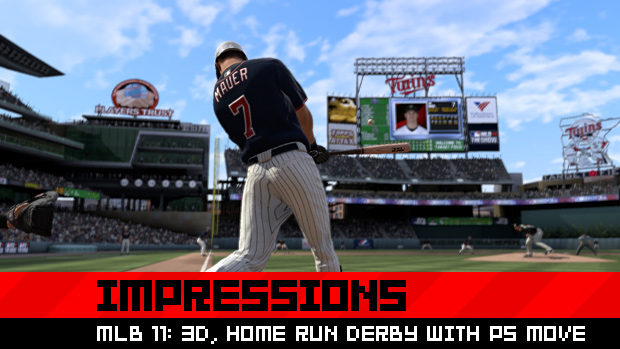When I first checked out MLB 11 The Show a few weeks ago, I spent a portion of the hands-on demo playing the game in 3D. I also tried the Home Run Derby mode, which debuted last year and now supports PlayStation Move.
Sony San Diego patched in 3D support for MLB 10, but the studio enhanced the implementation this year, and even as a person who doesn’t particularly care for 3D one way or another, I have to admit that it looks fantastic. I don’t usually enjoy 3D in videogames when it consists of objects flying out of the screen toward your face, which is why I like the more subtle style of 3D that MLB 11 employs.

The depth goes “into” the screen, as on the Nintendo 3DS, while the HUD elements — including the score line at the top of the screen, any statistical or interface overlays, and baserunner windows when you’ve got men on first or third — stand out because they float “above” the screen. The Show doesn’t shout “THREE-DEE” from the rooftops, and it’s much more enjoyable for it.
Even better, the options menu includes a slider that functions similarly to the physical slider on the body of the 3DS, allowing you to customize the subtlety of the 3D effect. Just for kicks, I turned it up all the way, which led to some very unpleasant ghosting for me. I assume that’s because I’m severely nearsighted and I wear fairly thick eyeglasses — as it is, I have to deal with slight chromatic aberration at the edges of my lenses. As with any 3D effect, your mileage may vary; I found the effect most comfortable when I set the slider at about 30 or 40% full.

Home Run Derby is little more than a fun diversion from the meat of MLB 11, and I was alternately impressed and disappointed by the implementation of PlayStation Move in the mode. I should mention at the outset that HR Derby is the only part of MLB 11 that supports Move; you can’t use it for anything else.
When playing a Derby with Move, your slugger doesn’t appear in the batter’s box; all you see is a bat floating in mid-air. I found the tracking of the wand to be highly accurate, just as in most Move games I’ve played — the orientation of the on-screen corresponds to the position in which you’re holding the wand.
But that’s about as far as the accuracy goes; as for the actual act of swinging, you might as well be playing Wii Sports. You can stand up and get in a batting stance if you really want to, but it’s by no means necessary (although you do have to swing left-handed, or backhanded, if your hitter is a lefty). I was able to blast a ball over 470 feet just by flicking my wrist gently — hitting depends only on the timing of the swing and the angle of the bat. (If you swing downward, for instance, you’re just going to drive the ball into the ground.) That is, you can have just as much success with a full home-run hitter’s swing as with a quick motion of your wrist.

I was initially expecting the mode to demand a more true-to-life swing, but the PR rep pointed out that the Derby is something you’d generally only play as a party game. And you sure as hell don’t want to be the one guy at a party who’s taking everything way too seriously, pretending to be David Ortiz — spitting in your hands and all — while everyone else is just messing around, trying to have a good time.


